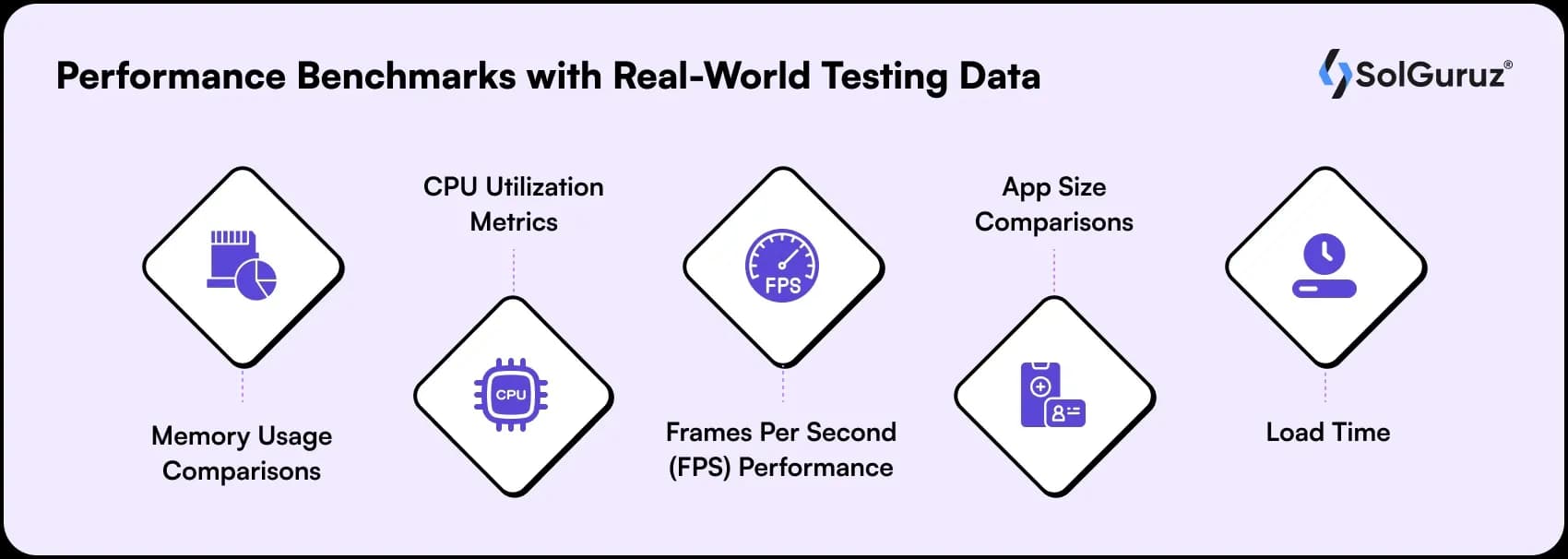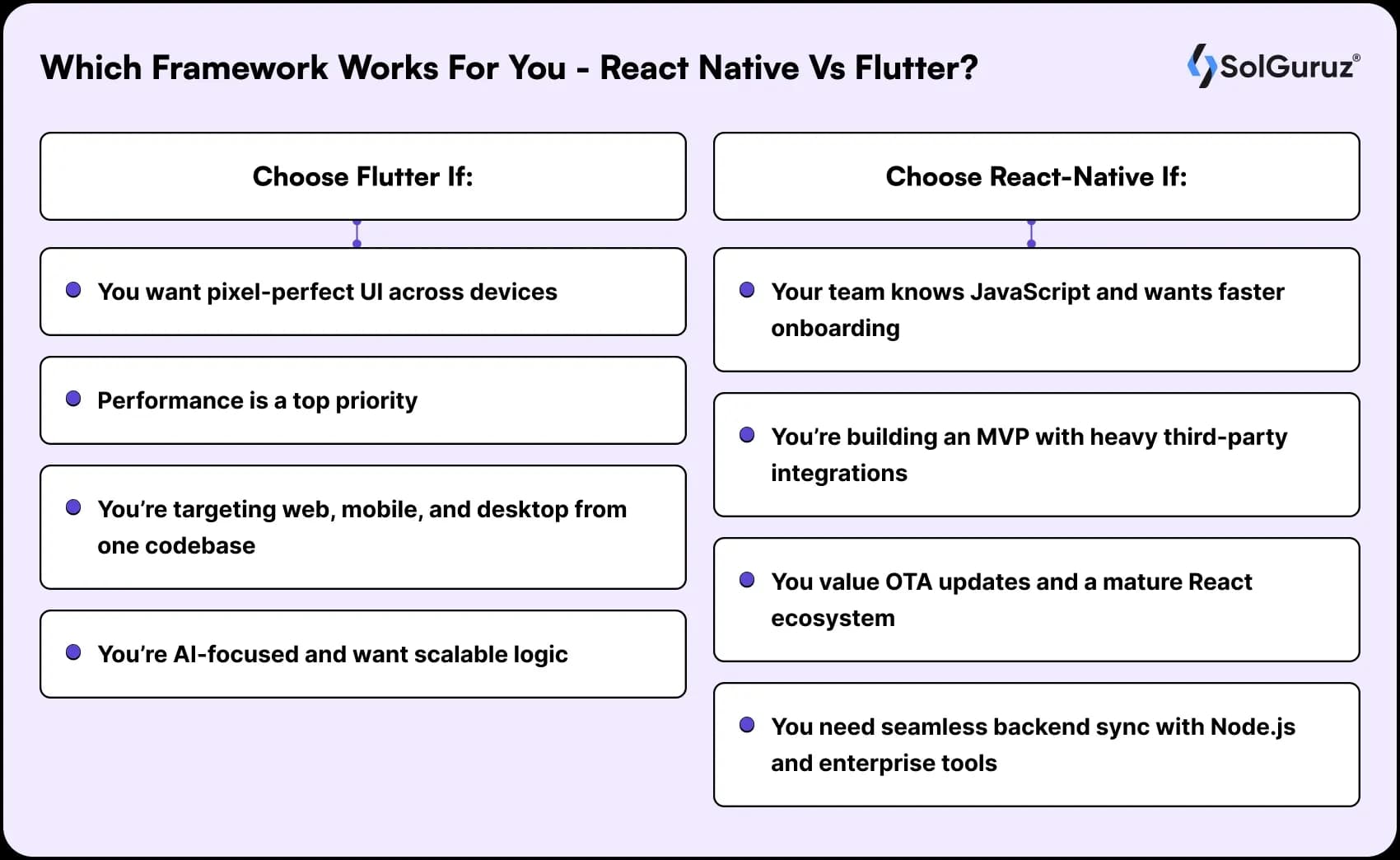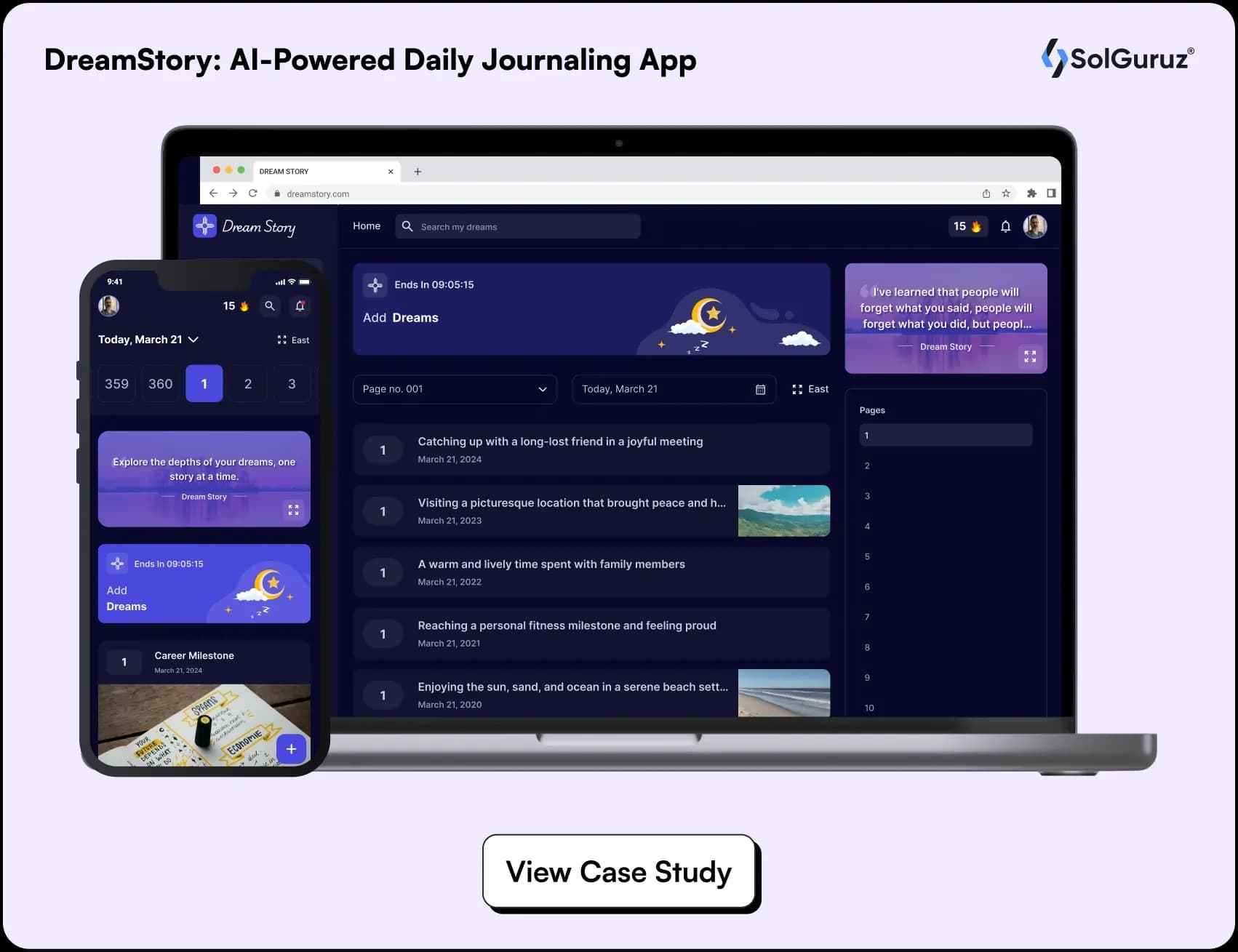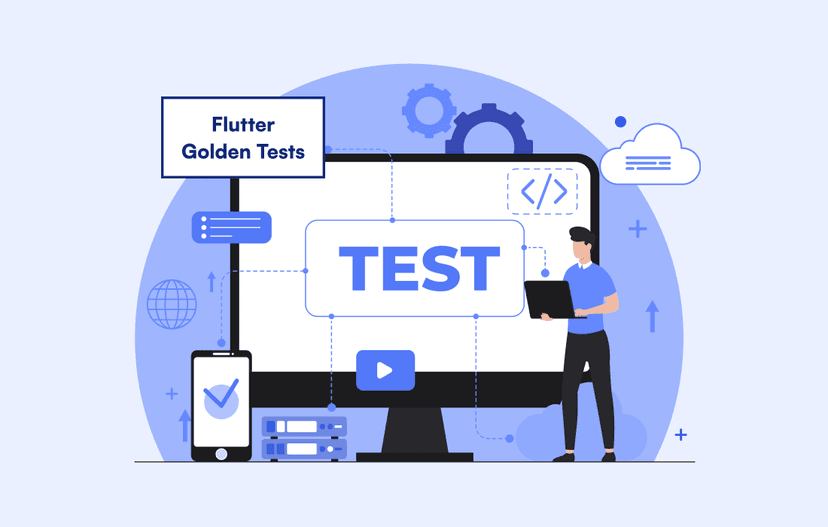Flutter vs React Native – Which One Rules in 2025
Gain insights into Flutter vs React Native in 2025 with our thorough comparison. Evaluate the mobile app development frameworks on their performance, architecture, code reusability, and standout features. Read the blog and choose the right framework for your project.

Thinking of building a cross-platform mobile app in 2025 but can’t decide which framework wins the Flutter vs React Native comparison?
You’re not alone. Most founders get stuck or confused at this stage.
But with two powerful options – Flutter and React Native – how do you choose wisely?
- Which one handles AI and 5G better?
- Which performs smoother under load?
- Which is easier to hire, maintain, and scale?
- And which one actually makes sense for your specific use case?
Choose the wrong cross-platform framework in 2025, and you might face sluggish performance, bloated maintenance costs, and frustrated dev teams. Choose smart, and you’ll have a fast, scalable app users love.
Most blogs stop at feature tables. We won’t.
In this blog, we’ll show you:
- What matters in real-world performance? (not just GitHub stars)
- How are enterprise companies choosing frameworks based on revenue goals?
- Where AI, 5G, and modern dev tooling fit in your long-term tech stack?
If you’re building an app that needs to last, this is the comparison you’ve been looking for.
By the end of this comparison, you won’t just know the difference between Flutter and React Native.
You’ll know which one is built for your product’s future.
TL;DR – This info is for those who want to understand the difference without any technicalities.
Table of Contents
So, What is the Real Difference Between Flutter and React Native?
Let’s imagine you’re building a mobile app.
Do you want your app to look the same on iOS and Android, down to the pixel?
→ Go with Flutter. It gives you full control over how your app looks and behaves.
Do you want your app to look and feel like a native iPhone or Android app?
→ Go with React Native. It uses the built-in buttons and menus from the phone’s OS.
Do you need your app ready super fast, and do you already have JavaScript developers?
→ React Native will save you time.
Want an app with amazing animations and graphics-heavy content (like AI tools or gamified apps)?
→ Flutter wins here hands-down.
Thinking of expanding your app to desktop or web later?
→ Flutter is more future-ready.
Rely heavily on third-party plugins or existing JavaScript tools?
→ React Native has a bigger plugin ecosystem.
Quick Flutter vs React Native Comparison Table
| Feature /Parameter | Flutter | React Native |
| Backed By | Meta (Facebook) | |
| Official Release | 2018 | 2015 |
| GitHub Stars | 172k (August 2025) | 123k (August 2025) |
| Programming Language | Dart | JavaScript |
| Architecture | Skia + C++based Impeller Engine (no bridge) | Bridgeless Architecture |
| Hot Reload / Fast Refresh | Yes (Hot Reload) | Yes (Fast Refresh) |
| Performance | Close to native like. | Good performance. |
| Code Reusability | ~90% across Android, iOS, Web, Desktop | ~80% across Android and iOS |
| UI Components and
Design Flexibility | Rich set of customizable widgets | Native look and feel; uses system components |
| Community Support | Rapidly growing | Larger, more mature community. |
| Learning Curve | Steeper due to Dart | Easier for JS/React developers |
| Third-party Libraries | Increasingly strong ecosystem | Extensive and mature ecosystem |
Who Can Benefit From This Blog?
This guide is built for:
- Startup founders launching MVPs fast with limited resources
- Product managers juggling timelines, UX, and stakeholder pressure
- CTOs/Tech leads deciding on long-term architecture and scalability
- Enterprise leaders are choosing frameworks based on cost, compliance, and user retention
- Developers looking for a future-ready stack and stronger DX
Struggling with which persona you are? Stick around – we’ve tailored this blog with your specific needs in mind.
Cross-Platform Framework 2025 – Flutter X React Native
Here is an overview of both the cross-platform frameworks. These frameworks are leading the app development market along with others like Xamarin, PhoneGap, Ionic, and more.
What is React Native?
The React Native framework is a relative of React, which was already in the game. Backed by Facebook(no, no, now it’s called Meta) came in 2015. It comes with new features to support cross-platform app development. Building apps that give a native-like feel.
What is Flutter?
Flutter is Google’s progeny to compete in the cross-platform market with other frameworks. Came in 2018 with a whole lot of superb UI and animation features.
Performance Benchmarks with Real-World Testing Data

Here is a detailed Flutter vs React Native performance comparison with various benchmarks like memory usage, CPU utilization, and other factors.
-
Memory usage comparisons
Memory consumption for cross-platform frameworks is heavier. When compared, Flutter (120-130 MB) matches native like memory consumption. React Native (180-190 MB) is heavier as compared to Flutter.
-
CPU utilization metrics
Flutter takes up to 5-8% of the CPU, whereas React Native has 11-13% of CPU utilization. Particularly when complex UI elements, animation, or heavy data processing are included, Flutter shows lower CPU utilization when compared to React Native. This is due to its architectural factors.
-
Frames Per Second (FPS) performance
Flutter is designed to run at 60-120 fps, so when you talk about animation, you’ll get a smooth user experience. Compared to React Native, Flutter’s FPS is better due to many factors, like the rendering engine, programming language, widgets, and other factors. React Native (45-60 fps) is improving with its new architecture. The performance, as compared to Flutter, is slow depending on the complexity.
-
App size comparisons
When discussing the memory the app will occupy on your device, Flutter again takes the lead with almost 17 MB. Whereas React Native takes up around 22-23 MB.
-
Load Time
Flutter’s comparative load time is less than that of React Native. It’s just a few seconds, but when it’s a neck-to-neck competition, then a single second matters. React Native is improving its overall performance and startup time with new features like Hermes and Turbo Modules. (We are talking about them in detail in the next section)
Use Case – For Startup Founders Launching MVPs
If you’re a startup founder, choosing the wrong tech stack can mean shipping late, missing investor deadlines, or struggling to scale.
- Flutter helps you launch faster with stunning UI and lower maintenance cost.
- React Native can save weeks if your devs already know JavaScript.
New Architectural Improvements in 2025
It is 2025, and both frameworks have pushed the boundaries of what cross-platform development frameworks can do. With newer updates, new upgraded versions are coming to offer higher performance. Here is a table to give you a quick review of both –
| Feature | Flutter (Impeller Engine) | React Native (Bridgeless) |
| Rendering Layer | Direct (C++-based Impeller) | Native components via JS bridge |
| Graphics Performance | High | Improved (less than Flutter) |
| Startup Time | Fast | Improved with Hermes |
| Compatibility | Multi-platform (iOS, Android, Web, Desktop) | Mobile-focused (iOS, Android) |
| Stability | Very Stable | Improved but still JS thread reliant |
| Ease of Debugging | High (Good Dev Tools) | Medium (Dev Tools improving) |
React Native Performance – More About Bridgeless Architecture, Turbo Modules, and Fabric
With the new updates, React Native has addressed the “old bridge architecture” issue and introduced “bridgeless architecture,” focusing on performance, efficiency, and developer experience.
React Native Bridgeless Architecture 2025

“React Native Bridgeless Architecture” Courtesy: Linklist.com
The main goal of the new architecture – to eliminate the dependency on the JavaScript bridge for communication between native code and JavaScript.
The old architecture involved serializing and deserializing data as JSON across the bridge, which resulted in performance bottlenecks and asynchronous communication.
The new architecture is driven by JSI. It allows for direct and synchronous communication, circumventing this overhead.
- Eliminating the bottlenecks of JSON between JavaScript and native code.
- Reduced latency in UI rendering improves communication between components. This results in a responsive and smoother app experience.
- Better performance, reduced memory usage, and less overhead.
Hermes Engine
The new Hermes is an open-source JS engine developed by Meta. This is specifically optimized for React Native apps. It is designed to improve the performance of React Native apps on mobile devices.
“For many apps, using Hermes will result in improved start-up time, decreased memory usage, and smaller app size when compared to JavaScriptCore.” – React Native Official Document
Turbo Modules
These are next-generation modules, replacing the old ones.
- On-demand Loading Modules are loaded only when needed. Reducing the app startup time considerably.
- Direct Communication for faster data exchange, bypassing the bridge.
- Improved Type Safety as code generation is used to make sure there are reduced errors and consistency is there.
Fabric
The new rendering system aims to improve performance and sync with native platforms.
- Smoother animations and faster UI interactions.
- Fine-grained control over layouts and updates.
- Lazy initialization for faster app startup times.
Flutter Performance: More About Impeller engine, Dart 3 updates, Web & Desktop Maturity
It’s came up with newer updates, replacing the old “Skia engine” with “Impeller rendering engine”.
Flutter Impeller Engine

“Flutter Impeller Engine” (Courtesy)
The next-gen engine for Flutter to address performance and jank issues. Flutter impeller engine performance is improved, resulting in a more consistent user experience.
- Replaced Skia with Impeller
- Improves frame stability
- Predictable jank jank-free animation means improved native-like performance.
Dart 3 updates
- It is now sound-null safe.
- Improved foreign function interface (FFI) to easily integrate with native C++ code.
- Smoother multi-threading.
Web and Desktop Maturity
Web – With Flutter for web, developers can create interactive web experiences using the same codebase as their mobile apps. With responsive layouts and integration with web-specific APIs, it is a viable option for creating web applications with a rich UI.
Desktop – Flutter offers reliable support for developing desktop applications across Windows, macOS, and Linux. This allows developers to aim for various platforms using one codebase, providing a uniform user experience on different devices. The maturity of desktop development with Flutter is enhanced by features such as native windowing, file system access, and platform-specific integrations.
While choosing between React Native and Flutter app development company, give a good thought to the performance of both frameworks.
Use Case – For CTOs and Technical Decision Makers
Choosing a framework isn’t just a developer decision – it’s a system architecture decision.
- Flutter’s unified rendering pipeline and on-device inference is adored by many CTOs.
- React Native wins for those doubling down on JS-based infrastructure.
Business Impact Analysis
- Market share data – Flutter has a 19% share in the Play Store and 13% in the App Store. Talking about React Native, the numbers might be lower on the App Store or Play Store, but it is leading in revenue generation. It leads in app monetization and retention metrics.
- Enterprise adoption trends: 35% of RFPs in 2024 specifically requested framework choice. Enterprises needing faster MVP to market time are inclined to use React Native. Flutter for enterprises can be used in creating custom UI-driven apps.
- Developer salary insights: The average salary for a React Native developer is $115k, whereas for a Flutter developer is $95k. Enterprises favor React Native developers more because of their familiarity with the JS ecosystem.
- App Monetization and Engagement Metrics
| Metric | React Native | Flutter |
| Average Revenue Per App | $32,000/year | $24,500/year |
| User Retention (6 months) | 41% | 38% |
| Session Time (avg) | 4.3 mins | 4.1 mins |
| Ad Integration Flexibility | High (via third-party libraries) | Medium (best with Google ecosystem) |
Use Case – For Enterprise Stakeholders
Enterprises choosing frameworks today consider more than features – they prioritize cost of ownership, compliance, and hiring stability.
SolGuruz has helped multiple enterprises choose the right stack by running custom RFP tech audits.
The Battle Begins Here – Flutter vs React Native

We are taking the battle on different rounds, measuring different levels like popularity, UI/UX design, features, and other things.
Round 1: The UI/UX Design Battle
Flutter: It has rich custom UI widgets. With so many options and customizations, you are free to design your imagination. Known for its expressive and flexible UI, Flutter leverages its proprietary widgets, providing developers with complete control over app design. Along with consistency, it allows for intricate customizations, making it ideal for visually complex apps.
React Native: Relies on native components to render its UI, which means the look and feel of the app adapts to the platform’s native design standards. While this ensures a more native-like experience, it may require additional effort to achieve identical designs on both iOS and Android.
Round 2: Hot Reload
“Hot reload” is one of Flutter’s most outstanding features.
Without having to restart the application, developers can make changes to their code and see those changes reflected instantly. Enabling rapid iterations greatly reduces development time and increases productivity.
Similarly, in the React Native framework, there is Fast Refresh, a functionality resembling the hot reload feature. By enabling developers to view changes in real-time without losing the app’s state, Fast Refresh improves the development experience. Almost instantly, Fast Refresh updates the application whenever you make changes to your code. You don’t lose your existing app state, which is very helpful for testing new features. Fast Refresh will enable you to correct any errors in your code without having to restart the entire application.
If you are looking to Hire react native developers then you can connect with a React Native app development service like SolGuruz. Next, let’s look at the code reusability of both frameworks.
Round 3: Code Reusability
Flutter: Developers can create code in Dart, the only language supported by Flutter, and have it compiled to native iOS and Android. This also makes it much easier to reuse code between the two platforms, which saves time and development resources. Given that Flutter is still a relatively new technology, code reuse could be improved. In Flutter, state management is a complex yet crucial feature.
Read our essential guide on Flutter state management to learn how to manage the different states of Flutter.
Pro Tip: Hire Flutter app developers who have experience with state management and working with different packages.
React Native saves development time and effort by enabling code reuse across platforms. When it comes to reusing the codes across mobile devices, React Native lacks skilled developers and support resources.
Round 4: OTA feature
Over-the-air OTA is the ability to push immediate updates. In the current competitive landscape, this feature is quite valuable.
React native: React Native’s support for OTA updates enables the quick and easy deployment of app upgrades. This is also due to the framework’s well-evolved structure and age.
Simplified Update Procedure- By avoiding the conventional app store update cycles, developers may swiftly fix defects or make enhancements thanks to the framework’s OTA update capability.
Improved User Experience- By guaranteeing that users always have access to the most recent version of the app, this feature affects user satisfaction and engagement. Anyone providing React Native development services will know that the key to a fast app is faster updates.
Flutter: Historically, developers had to use more intricate workarounds since Flutter lacked native OTA update capabilities. However, recent developments in the Flutter framework are altering this scenario.
Emerging OTA Update Support- A third-party service called Shorebird has added code push capabilities for Flutter apps, allowing for immediate updates to be sent to iOS and Android devices.
Considerations for Implementation- Although encouraging, Shorebird and other similar tools need more integration work and might not yet be as developed as React Native’s OTA ecosystem.
Round 5: Learning Curve
React Native: React Native is simpler to learn from the developer’s perspective, and there’s a good reason for that: it employs JavaScript as its programming language. The majority of developers are familiar with JavaScript because it has been around for years.
Flutter: Flutter uses Dart, which is relatively recent and could expand the learning graph. However, Dart doesn’t make Flutter a difficult framework. Rather, it is a characteristic that distinguishes Google’s platform.
Round 6: Community Support
React Native: For many developers, assistance from the international development community can be quite helpful while pursuing cross-platform development. Given that React Native was introduced far earlier than Flutter, a sizable online community providing assistance is to be expected. Readily available solutions for common problems.
Flutter: Nevertheless, Flutter has a constantly expanding developer community due to its status as a rising star, and it is anticipated to reach a significant size in 2020. Therefore, the lack of community support and a lower maturity level shouldn’t be a major deterrent to using Flutter.
Round 7: Backend Compatibility
Flutter: It is a popular option for Flutter projects since it integrates easily with Firebase, another Google product. Firebase makes it simple to integrate databases, storage, cloud services, and authentication.
Any backend provider, such as Google Cloud, AWS Amplify, and bespoke backends, can be integrated with Flutter. Dart’s ability to manage HTTP requests and establish a connection with any cloud service that has an API accounts for this versatility.
React Native: Due to its shared use of JavaScript, it works well with Node.js and enables smooth backend integration. The shared environment of JavaScript makes Node.js a popular choice for React Native applications.
Any backend solution, including Firebase, AWS Lambda, Google Cloud Functions, and others, can be integrated with React Native. Given its compatibility with RESTful APIs, GraphQL, and related technologies, it offers backend integration flexibility that is on par with Flutter.
Read more if you want to know the cost to hire a Flutter developer in detail. This means cost isn’t the primary differentiator. Instead, focus on framework compatibility with your project’s unique requirements.
Round 8: Documentation
React Native: General documentation is provided by React Native. The framework makes extensive use of third-party developer tools. The documentation is more intricate than Flutter.
Flutter: It provides easily comprehensible documentation due to its organization and comprehensive information. The documentation is also more effective and lucid.
AI Integration & Future-Proofing Considerations
When discussing long-term product success, AI integration and scalability readiness are crucial factors that can’t be overlooked. So start with
-
How does each framework handle AI-driven updates and scalability?
When you are working with React Native, it facilitates AI integration and scalability with
- Easy integration with AI API using Java SDKs
- Supports real-time updates for chatbots and voice assistants. Also supports background sync.
- Supports via ONNX.js and JavaScript libraries.
While you are working on AI integration or scalability in Flutter
- Direct support for TensorFlow Lite and OpenAI APIs.
- On-device inference with lower latency. Works well with features like object detection, face detection.
- Support for OTA AI models pushes through tools like Shorebird.
-
5G optimization potential
Optimizing your application and hardware with the latest internet generation to take advantage of it fully.
- Flutter renders complex AI-powered UI through Impeller Engine.
- React Native works well with real-time features using GraphQL and WebSocket.
-
Compatibility with LLMs & prompt engineering workflows
Working with AI means optimizing your systems and channels for LLMs. Making them compatible with LLLMs can work as an additional benefit. React Native is great for prompt chaining or real-time transcription. Flutter is better for on-device execution.
Now that we’ve seen how Flutter and React Native compare in terms of AI-readiness and future-proofing, let’s look at how it all plays out in the real world.
How SolGuruz Scaled “Dream Story” with Flutter + AI
When a solo founder approached SolGuruz, they didn’t just want an MVP.
They wanted a product that would:
- Feel personal and magical to users
- Could track the personal growth of users
- Help build healthy habits with AI
- Improve over time without breaking
We built Dream Story, an AI-powered journaling app using Flutter + OpenAI + Firebase, designed to scale from day one.
What We Built:
- Frontend: Flutter with clean UI components and animations
- Backend: Firebase + Node.js with secure endpoints
- AI layer: OpenAI API + custom prompt engine for rewriting content
- Maintenance architecture: Automated retraining pipeline, prompt version control, and real-time error tracking
Results:
- Featured on Product Hunt within 48 hours of launch.
- 4.9/5 average user rating on launch month.
- Less than 1% crash rate.
- Zero model drift due to weekly prompt checks and data logs.
This case study proves one thing: It’s not just about building apps with Flutter or React Native.
It’s about maintaining them with performance and intelligence baked in.
Developer Experience & Hiring Considerations
Development is all about the people behind it and the product. Developer experience (DX) affects your speed to market, team morale, and even your hiring costs.
Hiring Trends & Developer Availability
React Native
More developers are available globally due to JavaScript’s popularity. Easier to hire quickly, but top talent often demands higher salaries.
Flutter
Growing developer base, especially in Eastern Europe, South Asia, and LATAM. The average salary is lower than that of React Native developers. The talent pool is growing slowly.
Use Case – for Developers and Product Teams
For developers comparing frameworks, the learning curve, tooling, and community support matter.
React Native offers smoother onboarding if you’re from the JavaScript world.
Flutter lets you create polished UIs with full control – works great if you’re into graphics, gaming, or AI.
Times When You Can Use Flutter
When working with Flutter vs React Native, there will be a question in your mind – “When can I use Flutter, or when is Flutter better than React Native?” Here are some suggestions –
- When you want a high-performance gaming app or an app that heavily depends on animation or graphics.
- Having said that, when your app requires customized UI designs. Extensive custom libraries in Flutter allow for your desired permutation and combination of UI designs.
- You want a unified codebase because you are developing for a variety of platforms, including desktop and online, in addition to mobile.
- When you have budget restrictions, you have to give effective outcomes on a smaller budget.
Times When You Can Use React Native
- If your team is already comfortable with JavaScript, development can proceed more quickly, and onboarding can go more smoothly with React Native.
- If you need a native look and feel for your cross-platform app, your software must work effectively on both the iOS and Android platforms.
- Because React Native’s ecosystem is more developed, your project depends on a large number of third-party libraries.
Which Framework Works For You – React Native vs Flutter?

One framework does not fulfill all your requirements. It is not about the debate of Flutter vs React Native; it is about which framework works best for your product and aligns well with your goals.
For a smarter, long-term decision, consider your team, goals, and budget.
Choose Flutter if:
- You want pixel-perfect UI across devices
- Performance is a top priority
- You’re targeting web, mobile, and desktop from one codebase
- You’re AI-focused and want scalable logic
Choose Native if:
- Your team knows JavaScript and wants faster onboarding
- You’re building an MVP with heavy third-party integrations
- You value OTA updates and a mature React ecosystem
- You need seamless backend sync with Node.js and enterprise tools
If you decide on Flutter and want to hire Flutter developers on demand, then you can contact us.
Still need help?
FAQs
1. Which is Better in 2025 - React Native or Flutter?
Both are strong competitors and are strong choices. If you want to focus on animations, impressive UI elements, then Flutter is your best choice. If you are looking for developer familiarity and a mature ecosystem, go for React Native. The choice ultimately depends on your project needs and end goals.
2. Is Flutter Faster Than React Native?
In general, Flutter has superior performance to React Native. Due to its architecture and native compilation, it has smooth UI rendering.
3. Which is More Cost-Effective - React Native or Flutter?
When compared to native development, both frameworks are cost-effective as cross-platform solutions. React Native can prove to be cost-effective for enterprises or solutions that have a JavaScript ecosystem. Flutter can be cost-efficient when complex UI renderings are needed.
4. Is Flutter Better for AI and Future-Proofing?
Flutter supports AI integration with TensorFlow Lite and OpenAI APIs. React Native supports AI integration through ONNX.js and JavaScript libraries. For heavier apps, Flutter has an edge over others.
5. Can I Use Flutter or React Native for My Enterprise-Grade App?
Yes, both frameworks are used in enterprise-grade apps. Flutter is used in Google Pay and BMW, while React Native is used in Instagram and Walmart.
Build Cross-Platform Apps
Leverage the power of Flutter and React Native services to build cross-platform applications.

Strict NDA

Trusted by Startups & Enterprises Worldwide

Flexible Engagement Models

1 Week Risk-Free Trial
Give us a call now!

+1 (724) 577-7737



